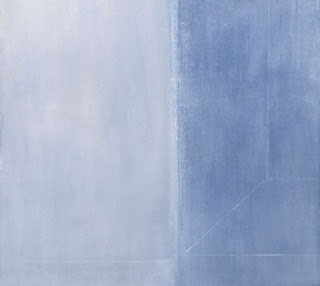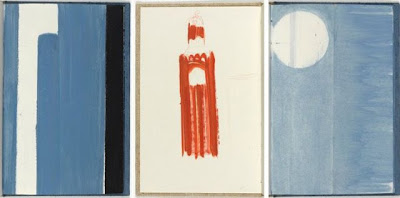 |
| Geneviève Asse, Ligne blanche intérieure, 1971 |
Geneviève Asse’s paintings tick three of the most important
boxes on my list of what I love about painting. First, they are about painting,
second she spends a lifetime exploring the space between things, making that
space exist, like giving vision and tactility to air, and third, she does all
this in a palette of blue. For most of the tourists visiting the Pompidou
Centre in August, the two rooms of Asse’s paintings in this small exhibition on
the fourth floor were an opportunity to have a rest. In an unusual tendency for
the Pompidou, there were two long benches to sit on, presumably because as the
catalogue explains, the paintings require time to reveal themselves. For me,
these paintings were so rich and provocative that I sat on the benches and
marveled, once again, not making it upstairs to the Pierre Hantai paintings on
the 6th floor, my reason for being there.
 |
| Geneviève Asse, Le Cercle Paysage, 1966 |
Asse’s paintings are about blue, shades of blue and white,
the moment when blue becomes grey, blue in its verticality, horizontality, in
the polychromatic scale of lulled blue. The paintings are about light and
space, they remind me of so many things, but rarely of anything
representational or figurative. There are times when Asse paints doors and
windows, in white, blue and grey, though I am only able to recognize the these
objects because of the painting’s title. What’s so fascinating about them is that
unlike Rothko, the longer I sit with the paintings, the more real they become,
the more concrete, the more the spaces open up and the space between an open
door and its frame becomes a reality. The longer I sit with the paintings, the
less relevant the objects become, the more significant the space between them.
A painting such as La Porte 1967 is
also about a door being opened, about movement as well as giving substance to
the light that enters into a space, a light that was previously not there. The
verticality of the painting mirrors the shape of the door, ensuring that the
door is not forgotten.
 |
| Geneviève Asse, La Cuisine, 1946-47 |
I see Chardin in the sill lives such as La Cusine, in which space is made an object, and objects fall out
of space. There is also something Vermeer-like about the paintings, which is
not mentioned anywhere in the literature on Asse, critics preferring to
underline the connections to Giorgio Morandi, for example. Like Vermeer, Asse
captures different spaces, and the light begins to fall through
three-dimensions, and indeed, over time creating the dimensionality of the
space. And then eventually, the paintings move into abstraction. Standing
before a work such as Cercle Paysage,
1966, a work in which Asse digresses from blue to paint a red circle through
it, I also see the influence of Nicolas de Staël. Though of course, I might
have seen the correspondence to de Staël in other of her paintings because it
is as if they are executed in the same breath. Like de Staël’s paintings, Asse’s
are about the air, about luminosity, space, volume, dimension, never centred,
never logical, always making real the things that don’t exist.
 |
| Geneviève Asse, Stèle no. 4, 1996 |
As I do when I look at a
de Staël painting, I see the sea and sky in the 7 huge vertical blue and
blue images. These works also remind me of Brice Marden’s works in grey, but
the surface resemblances of the image is where the similarity between Asse’s
work and anything being produced in the postwar period in America stops. In
Asse’s seas and skies, the horizon has been made vertical, a verticality that
troubles if we are to see it an horizon. Perhaps it is not figurative at all.
In the sketchbooks also on display here, notebooks filled with paintings, the
images are more clearly figurative, the seascape being more convincingly
represented. Many of them are done at a place by the sea, and she has painted sailing
boats, the sun, as well as the sky and the sea with the horizon that separates
them.
 |
| Geneviève Asse, Sketchbook Pages |
In all of these works, the middle of the painting is troubling:
whether it is vertical or horizontal, the middle becomes a problem. In some
works Asse places a vertical metal strip down the middle, a harsh band that
divides, but never fully defines what lies on either side of it. The metal band
is also the place where the paint stops, where there is a space between
colours, between parts of the painting meet, but never quite meet. Even though
he figured this place differently, it’s the place on the canvas that reminds me
of Marden. Also, Marden’s paintings were grey – somehow Asse’s works are not
pushing at the same limits of abstraction because they are blue. Blue has a
significance that grey does not – blue is the colours of the sky, the sea, the
air, the space between things. We could also be reminded of Newman, the zip as
the most troubling place on the canvas – but again, unlike Newman’s Asse’s
abstraction never really becomes fully complete: the window frames and doors
and other defining shapes are always coming out of these spaces. There is
always or nearly always a dimensionality, an object, something concrete, often
thanks to the framings within the images, that can be found on these blue
canvases.
No comments:
Post a Comment